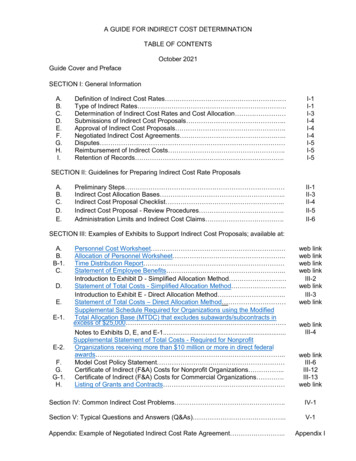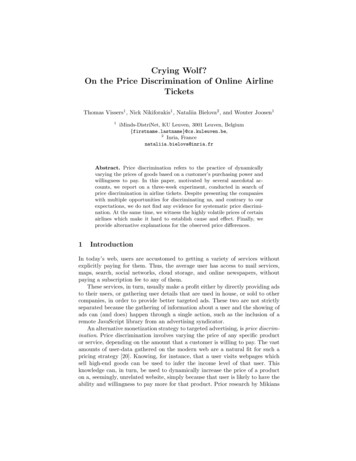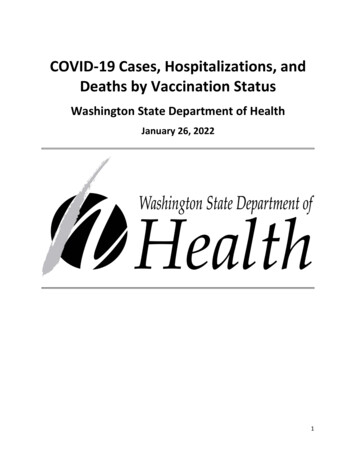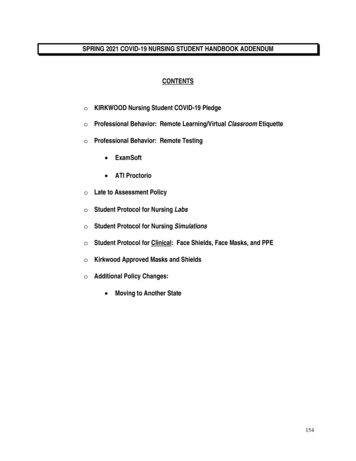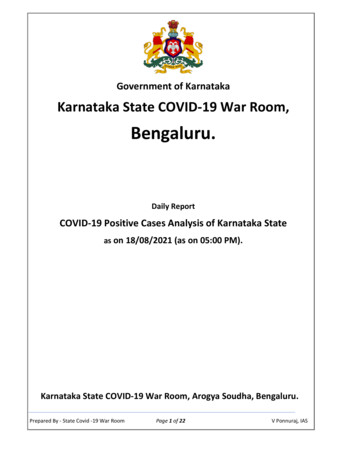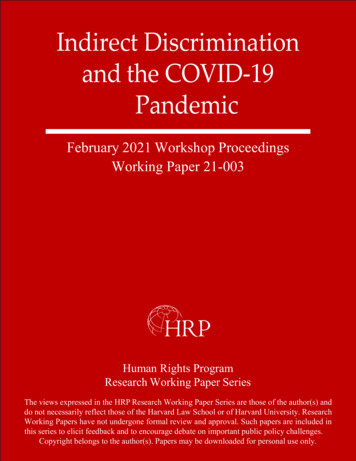
Transcription
Indirect Discriminationand the COVID-19PandemicFebruary 2021 Workshop ProceedingsWorking Paper 21-003Human Rights ProgramResearch Working Paper SeriesThe views expressed in the HRP Research Working Paper Series are those of the author(s) anddo not necessarily reflect those of the Harvard Law School or of Harvard University. ResearchWorking Papers have not undergone formal review and approval. Such papers are included inthis series to elicit feedback and to encourage debate on important public policy challenges.Copyright belongs to the author(s). Papers may be downloaded for personal use only.
Table of ContentsFebruary 2021 Workshop Proceedings 1Introduction 1Segment One: Short recapitulation of the October workshop 2Segment Two: Discussion of hypotheticals in the Concept Note 4Segment Three: Particular elements of indirect discrimination: Theory and purpose(s) of theprohibition against indirect discrimination 7Segment Four: Particular elements of indirect discrimination: Evidence 13Segment Five: Particular elements of indirect discrimination: Justification 15Segment Six: Particular elements of indirect discrimination: Reparations 19Segment Seven: International oversight of national application 22Closing Discussion: Next steps 27Appendix I: References from the Workshop Discussion 29Appendix II: Concept Note for the Workshop on Indirect Discrimination, on BasesIncluding Sexual Orientation or Gender Identity, in the COVID-19 Pandemic 31Appendix III: Partial List of Participants in the Workshop 35Appendix IV: Working Papers 36Eva Brems 37Pieter Cannoot, Ghent University, Belgium 44Dorothy Estrada-Tanck 56Alice M. Miller and Jessica Tueller 60Gerald L. Neuman 75Flávia Piovesan and Jessica Tueller 83
1Indirect Discrimination and the COVID-19 PandemicFebruary 2021 Workshop ProceedingsIntroductionThe Harvard Law School Human Rights Program (HRP) convened a workshop on February 12,2021, for the purpose of exploring in a comparative and cross-disciplinary manner thephenomenon of indirect discrimination (or practices with discriminatory impact), on groundsincluding but not limited to sexual orientation and gender identity, during the COVID-19pandemic. This Report presents a summary of the discussion that took place (by remotetechnology) at the workshop, including divergent perspectives expressed. It does not attempt tosynthesize the arguments offered into a commonly shared set of conclusions – the polyphoniccharacter of the summary is intended as one of its virtues.Legal norms prohibiting indirect discrimination may be found in a variety of national laws,treaties, and other human rights instruments. The positive legal norms may differ in severaldimensions, including the purposes they are understood to serve, the public and/or private actorsthey regulate, the activities in which indirect discrimination is prohibited, the methods ofdemonstrating differential effect, and the standards for justifying differential effect. In thecontext of international human rights norms, other questions relate to the nature of theinternational oversight of the application of nondiscrimination rules by national authorities.Discussion at the workshop included examination of these questions, with regard todiscrimination on bases including age, disability, ethnicity, race and culture, gender, indigeneity,and religion, as well as intersectionality, but also questions such as the strategic value of framingarguments in terms of indirect discrimination, in comparison with other rights framings, and therelationship between remedies for particular groups and remedies directed at broader reforms.The workshop built on a previous HRP workshop in October 2020 that dealt specifically withindirect discrimination on the basis of sexual orientation or gender identity, and many of theparticipants in February had also attended the prior event. 1 Participants in February includedmandate holders of United Nations special procedures and the Inter-American Commission onHuman Rights, current and former members of international treaty bodies, academics fromProceedings of the October 2020 workshop are posted as a Working Paper on the HRP ds/2021/05/IndirectDiscrimination WorkshopProceedings October2020.pdf , and onSSRN, https://papers.ssrn.com/sol3/papers.cfm?abstract id 3843395 . These workshops were part of aseries, which began with an April 2020 workshop on indirect discrimination on the basis of religion orbelief. Papers from the April 2020 workshop were published as the Summer 2021 issue of the HarvardHuman Rights Journal, https://harvardhrj.com/symposia/.1
2Harvard and other universities within and outside the United States, former and current humanrights mandate holders, and human rights advocates from organizations within and outside theUnited States. The conversation proceeded in seven segments with overlapping content,followed by a closing discussion of next steps to be taken:1. Short recapitulation of the October workshop2. Discussion of hypotheticals in the Concept Note3. Particular elements of indirect discrimination: Theory and purpose(s) of theprohibition against indirect discrimination4. Particular elements of indirect discrimination: Evidence5. Particular elements of indirect discrimination: Justification6. Particular elements of indirect discrimination: Reparations7. International oversight of national applicationA list of formal references for some of the sources mentioned in the discussion is provided inAppendix I. The Concept Note for the workshop is reproduced in Appendix II.A partial list of participants may be found in Appendix III. The organizers of theFebruary 2021 workshop were HRP co-Director Gerald L. Neuman and Victor Madrigal-Borloz,the UN Independent Expert on protection against violence and discrimination based on sexualorientation and gender identity, who is Eleanor Roosevelt Senior Visiting Researcher at HRP.Dana Walters, Ellen Keng, Chetna Beriwala and María Daniela D. Villamil provided essentiallogistical support.Finally, Appendix IV consists of papers submitted for the workshop discussion, possiblyas revised after the workshop.Segment One: Short recapitulation of the October workshopVictor Madrigal-Borloz provided an overview of the discussion at the October 2020 workshopon the concept of indirect discrimination on the basis of sexual orientation or gender identity. Ithad followed the previous workshop on indirect discrimination on the basis of religion, and someof the discussions in the October workshop addressed the dilemmas of confluence or conflict,real or apparent, between freedom of religion and belief and the right to live free ofdiscrimination and violence based on sexual orientation and gender identity. That workshop hadabout 25 participants, similar to the number in the present workshop.The October workshop was divided into seven segments and one brainstorming segment. Itbegan with a comparative survey in which United States, European, Inter-American, andinternational human rights law standards were analyzed, describing commonalities anddifferences in how indirect discrimination has been codified. A main line of discussion running
3through the workshop began in the second segment, relating to the purpose of the prohibitionagainst indirect discrimination, and in particular the fact that structural discrimination is often theresult of a strong disconnect between the dominant group and victims in society; one expertpointed out that this is about regulating what a reasonable person in society ought to know aboutmarginalized groups and people who are unlike themselves. This idea of responsibilities inrelation to the knowledge of the other has a number of dimensions that are not only strictly legalbut also from the angle of ethics. Participants explored during the workshop certain perhapscounterintuitive traits of the concept of indirect discrimination, including its relation with notionsof absence of wrongfulness, the exploration of culpability and complicity, and its possiblerelation with notions of efficiency in society.All of these discussions formed part of the point of departure in the second segment related topurpose, but also flowed into the third segment related to the aspect of scope and themethodology of the norm, and the fourth segment related to justification and evidence. Thencame particular thematic discussions related to religion and sexual orientation and genderidentity, which tried to separate arguments that have been amalgamated in public, political andother types of discourse, especially combining issues of transcendence and legal protections andthe behavior of religious and faith-based institutions.Within this set of segments, a number of observations aimed at highlighting and discussing thedifferent contexts in which direct and indirect discrimination are used; in particular, they movedto the analysis of how indirect discrimination is a tool in the field of political advocacy that mayhave different traits from indirect discrimination when used in the language of litigation andadjudication. This led to a discussion of reparations, which will be summarized in more detail atthe beginning of a separate segment on that subject in the present workshop, which will beginwith the idea of non-repetition as a main driver of litigation about indirect discrimination.Two further observations – first, that a brief summary does not do justice to the richness of thedialogue, which has been documented to ensure that it becomes part of the knowledge stock.And second that the workshop in October verified the importance of intersectional thinking inthe analysis of discrimination. When talking about sexual orientation and gender identity, it wasoften noted that the analysis involving power relations must also take into account issues ofpoverty, gender violence, and other basic determinants of experiences of privilege ordiscrimination for different persons.The final segment in the workshop, after one on international oversight, focused on the openquestion whether legal arguments based on indirect discrimination are useful orcounterproductive in the current situation. Hopefully the present workshop will show thatindirect discrimination can be an extraordinarily useful construction for the purpose ofaddressing violence and discrimination in the lived experiences of people.
4Segment Two: Discussion of hypotheticals in the Concept NoteThe segment moderator began by recalling the three hypotheticals in the concept note, andhoping that it would be possible to address all three of them in the segment.The first hypothetical is about access to health services, specifically gynecology, for transgenderpersons, with a number of subquestions about when this is an issue of discrimination and how itshould be approached in national or international law. This brings us immediately to the issue ofstructural discrimination, and a particular type of structural discrimination that has beenrecognized relatively recently, which gives rise to even more questions regarding who can fairlybe held responsible for this type of discrimination. One participant, Pieter Cannoot has discussedthis hypothetical extensively in his paper, identifying a number of challenges inherent in theapplication of an indirect discrimination framework to this case, and also proposing severalframeworks. Also the paper of Alice Miller and Jessica Tueller highlights in the context of thishypothetical how social activism can draw on work already done by sexual and reproductivehealth advocates and how this can be a terrain for joint advocacy work on gender.A first participant said that he was drawn to this hypothetical because his work has focusedextensively on the experience of trans persons, especially within the autonomy framework,which is often connected to one of the core struggles that trans persons face in society, the legalrecognition of gender identity. He has been thinking about the inherent value of the autonomyframework to move beyond some of the issues that an inequality/nondiscrimination frameworkconfronts us with, particularly the idea that the equality framework presents a certainassimilation, that women can aspire to rights that are already experienced by men in society. Theemerging right to gender autonomy can be applied to the hypothetical where a trans person isconfronted with the negative consequences of the structures of society, including how transpersons are overlooked in general health care settings. In the Belgian context it was striking thatwhen the gender recognition act was being changed nobody was really talking about the effectsof gender self-determination on the structure of society. The idea was pretty much that genderrecognition was only a trans issue, that gender autonomy was only a trans issue, and that it wouldnot have any consequences to the structure of society. Perhaps we can overcome some of theinherent challenges of indirect discrimination by focusing instead on a framework of genderautonomy which would imply negative obligations but also positive obligations on behalf of thestate to work towards structural change, cultural change, not only in the vertical relation betweenstate and individual but also in the horizontal relation between individuals. That wouldpotentially also involve a private medical professional (as in the Hypothetical) who does nothave any expertise in treating trans persons – whether within the autonomy framework thatwould be seen as a limitation on the capacity of a trans person to live up to their potential or tobe enabled by good health to explore their own ambitions in society.
5A second participant added observations from the Inter-American experience. First, AdvisoryOpinion No. 24 from the Inter-American Court explained that the lack of recognition of genderand sexual identity could result in lack of legal protection. It is a priority for the Inter-AmericanCommission on Human Rights and its Rapporteur for rights of LGBTI persons to disseminate theadvisory opinion on gender identity rights. Second, there is definitely an association betweenindirect discrimination and structural violence and violations of human rights. The InterAmerican Commission needs to attack the causes of structural discrimination and institutecomprehensive reparations. State legal duties to prevent based on guarantees of non-repetitionrequire transformative change in public policy and efforts to guarantee substantive equality.A third participant observed that the world of sexual and reproductive health advocacy, andprogramming and policy work, has really addressed this issue in the context of both individualprovider competence to do particular forms of care that are necessary to realize rights, and alsoof health justice, the notion that in health, structural determinants of health are always already tobe studied and intervened in. The recent report of the Office of the High Commission for HumanRights in regard to questions raised by the regulation of athletes, the report on race and gender inthe context of sport, has raised possibly for the first time the notion of autonomy as an element tobe spelled out in the human rights framework. The concept of autonomy requires multiple formsof rights guarantees – it is not only individually exercised, but is built on material conditions,which include access to the information necessary to understand what the rights constitute, theability to have the legal right to act on it, and the material conditions, including both access toservices and accountability for the competency of those services. In the health world this isassessed according to availability, accessibility, acceptability and quality. All of these standardsbeing built up as a health justice component are very useful to the present conversation.Another issue involves questions of fertility, and the way in which “trans-competent care”, andother forms of care are needed for people to guarantee the ability of both their bodies and theirselves to reproduce, whether as a matter of biology or as a matter of social reproduction.Infertility is caused by and becomes a component of discriminatory practices for many peoplewho are gender diverse or sexually different.A fourth participant added that previous gains by sexual and reproductive health advocatesinclude General Comment No. 22 of the Committee on Economic, Social and Cultural Rights(CESCR). It basically tells us that an individual provider could refuse care, but if there is anentire system that is refusing care, then we have a violation of the human right to health. Currentefforts to change such systems by abortion advocates would change medical education bytraining providers to provide care that would be considered controversial or unknown. This is anopportunity for joint advocacy work between groups.A fifth participant asked, as a bit of a provocateur, whether attempts to distinguish infertilityfrom what is sometimes called disfertility – that is, fertility problems that are not a result ofmedical reasons, as for single women, or lesbian women, or trans people – are an appropriate site
6for analysis in terms of indirect discrimination. One might hold the view that, as a matter ofhealthcare obligations, the distinction between infertility and disfertility was justified and notdiscrimination, and yet still consider that in terms of the state’s broader obligations it isdiscriminatory not to provide a non-health benefit to disfertile individuals to allow them toachieve what infertile people achieve by means of a health right. Is that too clever or too cute anargument, or too much separate spheres, or does it sound correct?To clarify further, when we consider what a “right to health” encompasses, it’s not all well-beingor happiness, but rather there is something narrower called “health.” One’s concept of healthmight be connected with something like species-typical functioning, or another kind of definitionby which infertility is a deviation from a proper health state, and people with infertility can makea claim similar to people with other disabilities, that they are missing something – as opposed tothe claim of disfertile people who want to realize their particular life plan but need assistance forreasons not relating to a deficit in their species-typical functioning. One’s claim as a gay personfor the state to pay for one’s childbearing and childrearing resembles more the claim (to borrowan example from T.M. Scanlon) that the state should pay for me to tithe to my God, because bothfurther a life plan that might be a worthwhile life plan, but are not a life plan that’s related tohealth.Another participant responded that the stated assumption about “species-typical functioning”sets up fertility and reproduction as a norm in a normatively objectionable manner. There areother ways of understanding the sort of human conditions that give rise to a concern forinfertility as a human right beyond access to health care. This would be an interestingdiscussion, but probably one that we don’t have time for in this workshop, before we could get tothe specific question that the fifth participant raised.The sixth participant added further aspects of infertility to the discussion, particularly relatingto indigenous peoples, including forced infertility as a result of chemical fertilizers and forcedsterilization of indigenous women and men.The segment moderator called attention to Hypothetical No. 6 in the Concept Note for theworkshop, involving an imaginary gender community that goes barefoot as an expression of theirgender identity, and members of that community who migrate to another country that hastraditionally banned going barefoot in public buildings on public health grounds. Thishypothetical resembles examples of religious discrimination against minorities, such as headscarfbans, and burkini bans, and so raises a classic reasonable accommodation case where thequestion is whether to grant an exemption from a general rule. When the cases concern religion,they can be discussed in terms of religious freedom, or sometimes freedom of expression or theright to privacy, or alternatively as discrimination on grounds of religion, or sometimes ongrounds of gender. In domestic law, the choice of the discrimination approach or the substantiveright approach can lead to very different types of reasoning. But in international human rightslaw, there is often parallel reasoning, whether it’s a discrimination framing or a substantive right
7framing, and the case will really turn on proportionality analysis. Whether the restriction of thehuman right or the lack of differentiated response is proportionate or not with regard to alegitimate aim. The European Court of Human Rights will generally examine such a case underthe substantive right, and then it will either say that it is not necessary to examine thediscrimination claim, or examine it briefly but refer to its reasoning developed under the otherright. If so, then what do we expect an indirect discrimination claim to add? Another choice fora supranational body is that they can either examine the facts relating to the justification of themeasure and evaluate the evidence themselves (for example the contested public health effect ofgoing barefoot in the hypothetical), or they can do a more procedural type of review, on whetherthe national authorities reasonably came to the conclusion that the measure was justified. Thislatter is of course a development that we see lately in the European Court of Human Rights,which is getting a very mixed review from scholars.The seventh participant began by emphasizing the difference, discussed in the Octoberworkshop, between a reasonable accommodation that privileges people on the basis of fittinginto identity boxes and a disparate impact remedy that basically asks whether there is a sufficientjustification for the rule as applied to anyone. In the United States, it seems that the privilegingof religion is intensifying, and is encouraging people to fit their desires and needs into presetboxes, especially the religion box; but it is not helpful just to add the gender identity box. Amore fruitful way of proceeding is to ask as the philosopher Brian Barry did years ago: if thereis not a sufficient justification to impose this rule on members of particular identity groups, isthere a reason to have the rule at all? The barefoot example illustrates this well, and there don’tseem to be many trade-offs in saying that anyone who wants to go barefoot may do so, althoughperhaps there should be publicity about the risks of earth-borne diseases or cuts in the theatre,whatever the health justifications or other material justifications there were for the rule in thefirst place. Rather than antidiscrimination reasoning, it would be better to rely on a right toprivacy or private life as in Article 17 of the International Covenant on Civil and Political Rights(ICCPR).Segment Three: Particular elements of indirect discrimination: Theory andpurpose(s) of the prohibition against indirect discriminationThe segment moderator began by describing lessons from the discussion in the Octoberworkshop of the theory and purposes of the prohibition of indirect discrimination. One easilyaccepted use of indirect discrimination relates to situations where intentional discrimination iscovered up, for example, where a government that is ideologically opposed to abortion closesdown all non-urgent medical services in the context of the pandemic, labeling abortion servicesas non-urgent. Evidence of discriminatory intent may be difficult to provide in such cases, butevidence of discriminatory impact may suffice. Intuitively, for ordinary citizens as well as for
8judges, this type of indirect discrimination is wrong for the same reasons that directdiscrimination is wrong, and in that sense they can be considered easy cases, although in practicethey may still be difficult to win. In a harder set of cases, the discriminatory impact of a measuremay not have been anticipated, or its problematic character may not have been recognized onaccount of the novelty of the issue or its complexity. These are cases of more hidden structuraldiscrimination. Now, from the perspective of the persons undergoing discrimination, some saidin October, the discriminatory effect is what matters; yet persons belonging to a dominant groupmay have a “fair world hypothesis” entrenched in their minds, as one of the interveners called it(i.e., an assumption that the system is generally fair and that instances of discrimination areisolated exceptions), and this attitude is an obstacle to recognizing nonintentional discrimination.This may explain why judges are often more hesitant to accept this kind of claim.In October, Victor Madrigal-Borloz pointed out the disadvantage of thinking in terms of intent,or good or bad faith. Arguably, there is a human rights obligation for policymakers to collectinformation on potential detrimental impact of policies on certain groups. This suggests that inreality there may not be such a clear line between those categories of cases, but rather acontinuum that includes policymakers deliberately targeting a group while covering it up, as wellas policymakers who anticipate disparate impact yet consider it acceptable collateral damage,and policymakers who don’t care to consider potential disparate impact. It was pointed out inOctober that one of the benefits of the indirect discrimination framing is that it compels anyonesubjected to the prohibition to think actively about impact on people who are not likethemselves; this was framed as an effect of the rule, but we could also see it as an obligation inhuman rights law.A lot of this reasoning in October seems to have in mind the responsibility of public authorities,not so much private parties. Should there be a distinction, perhaps, between the due diligencerequired of public authorities and that required of private parties, if we think in terms of anobligation to inform oneself of these disparate impacts? Or should we instead talk aboutdifferent standards and approaches between court-like settings and other settings of human rightsmonitoring, such as reporting procedures and special rapporteurs? Since the current participantsinclude a good representation of persons who work inside different supranational human rightsmechanisms, it would be interesting in this segment on theory and purpose of the indirectdiscrimination norm to hear how the purpose or potential benefits are seen in the context inwhich they work supranationally.The first participant referred to the dense experience of the Inter-American institutions indealing with discrimination. For the Inter-American Court of Human Rights, equality/nondiscrimination is a peremptory norm, part of jus cogens. The Inter-American Commission’srapporteurship on rights of LGBTI persons engages with the states especially to generatedisaggregated data. In the Inter-American system it is important to have empirical data,especially disaggregated data to demonstrate indirect discrimination, to show the impact, the
9effect, and then we have to deal with the principle of proportionality, and then after the diagnosisof this empirical basis, the question is how to react in terms of a transformative mandate tochange this reality. And here one would emphasize the notion of comprehensive reparation, inorder to deal with structural violations and foment social change. It is also important to mentionthe Inter-American Convention Against All Forms of Discrimination and Intolerance, which wasadopted in 2013, and includes the concept of indirect discrimination, with a broad scope of legalobligations implementing the right not to be subjected to discrimination. Indirect discriminationis a preferred instrument for reaching the transformative goals that the Inter-American systemaspires to, but at the same time in order to foment social change and deal with the structuralhuman rights violations, the reparations approach is needed.Victor Madrigal-Borloz said his mandate had gained substantial information in relation to theseissues throughout the COVID-19 response and recovery. No one had predicted the way thatCOVID-19 would produce impacts, the impact on economic conditions, the impact in terms ofphysical limitations, the way that sanitary measures would manifest themselves. In this context,the question arises of what seemingly neutral policies have created effects that ended up beingdiscriminatory. This account may be contested, but in his report on COVID-19, indirectdiscrimination analysis became a main motor, with contributions from some of the otherparticipants in the current workshop. One example involves gender-based quarantinesimplemented with a strong adherence to a binary understanding of how women and men look.Allowing people to go out and do their grocery shopping, on Mondays, Wednesdays and Fridaysfor one gender and Tuesdays, Thursdays and Saturdays for the other, immediately condemnspersons who do not necessarily fall within those boxes t
The Harvard Law School Human Rights Program (HRP) convened a workshop on February 12, 2021, for the purpose of exploring in a comparative and cross-disciplinary manner the phenomenon of indirect discriminat

